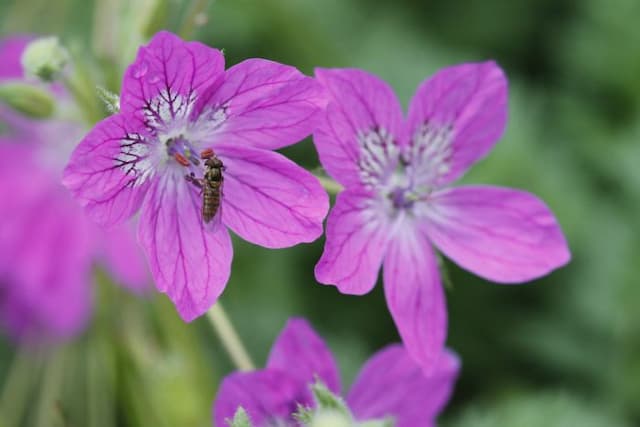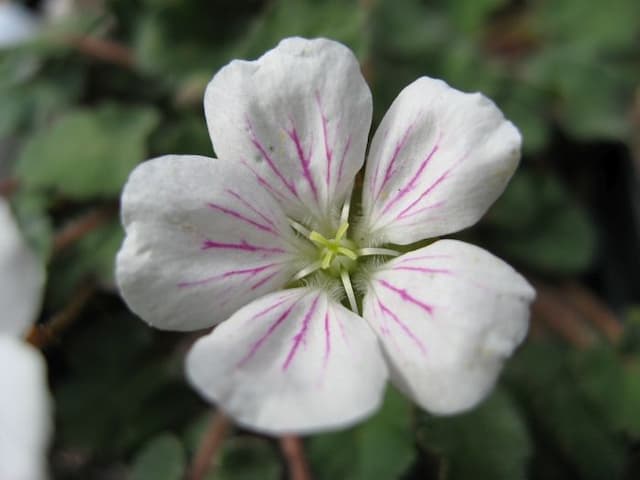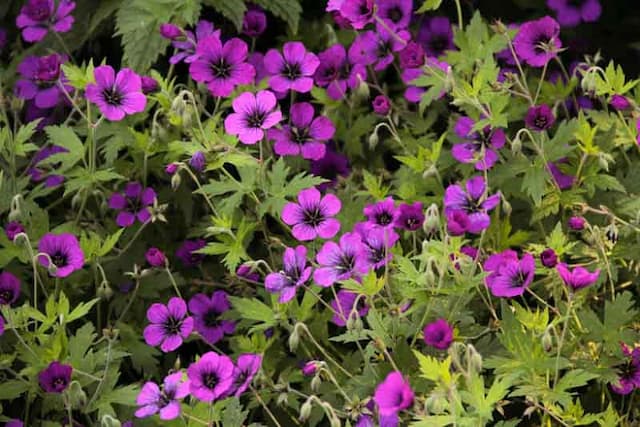Geranium Pelargonium 'Sefton' (R)

ABOUT
Pelargonium 'Sefton' is also widely known by the common name 'geranium.' This plant is often admired for its vibrant and showy flowers. The blooms have a distinct and appealing hue, often showcasing a bright pink or magenta coloration with striking vein-like patterns, which can range from darker tones of the same color to deep purples. Each flower consists of rounded petals that are clustered together in umbel-like formations, providing a full and lush appearance. The foliage of the 'Sefton' geranium is equally attractive, composed of leaves that are typically rounded, with a heart or kidney shape, featuring a soft, velvety texture. The edges of the leaves are scalloped or lobed, adding to the ornamental appeal. They are usually a deep green and might have a zonal pattern, which is a common characteristic in geraniums—a darker zone or band on the leaf, sometimes giving a marbled appearance. The stems of the plant are succulent and sturdy, supporting both the lush foliage and the abundant blossoms. Throughout the blooming period, the geranium's appearance is characterized by a harmonious balance between the verdant leaves and vivid flowers, making it a popular choice for gardeners seeking a splash of color in their garden beds, containers, or hanging baskets. The plant exudes a subtle yet delightful scent that adds another layer to its allure.
About this plant
 Names
NamesFamily
Geraniaceae
Synonyms
Sefton Geranium, Sefton Pelargonium
Common names
Pelargonium 'Sefton'
 Toxicity
ToxicityTo humans
Geraniums (Pelargonium species) are generally considered non-toxic to humans. Ingestion of geranium parts might cause mild gastrointestinal upset in some people, although such cases are relatively rare. There is no widespread or severe toxicity attributed to geraniums for humans.
To pets
Geraniums can be mildly toxic to pets, particularly cats and dogs. If ingested, they may cause symptoms such as vomiting, anorexia, depression, and dermatitis. In most cases, the ingestion of geraniums by pets does not result in severe poisoning but can lead to uncomfortable gastrointestinal upset and should be avoided.
 Characteristics
CharacteristicsLife cycle
Perennials
Foliage type
Evergreen
Color of leaves
Green
Flower color
Mixed
Height
1-2 feet (30-60 cm)
Spread
1-2 feet (30-60 cm)
Plant type
Herb
Hardiness zones
10
Native area
South Africa
Benefits
 General Benefits
General Benefits- Aesthetic Appeal: The Pelargonium 'Sefton' offers vibrant and colorful flowers, adding beauty to gardens, patios, or indoor spaces.
- Ease of Care: This plant is relatively easy to maintain, making it suitable for gardeners of all skill levels.
- Drought Resistance: It is tolerant to periods of low water, which can be advantageous in drier climates or during water restrictions.
- Attracts Pollinators: The blossoms can attract beneficial insects such as bees and butterflies, aiding in pollination of surrounding plants.
- Versatility in Landscaping: It can be used in various garden settings, including borders, containers, and hanging baskets.
- Fragrant Leaves: The foliage often has a pleasant scent, which can be a delightful addition to the garden or home.
 Medical Properties
Medical PropertiesThis plant is not used for medical purposes.
 Air-purifying Qualities
Air-purifying QualitiesThis plant is not specifically known for air purifying qualities.
 Other Uses
Other Uses- Pelargoniums can be used in the creation of scented oils and perfumes, as their leaves are often fragrantly scented, adding unique notes to fragrance blends.
- The crushed leaves of pelargoniums can act as a mild insect repellant, useful when rubbed on skin or placed around outdoor seating areas.
- Pelargonium 'Sefton' can be employed in potpourri preparations for their scent and aesthetic appeal, contributing to visually attractive and fragrant mixtures.
- These plants are sometimes used in educational settings for botany lessons, due to their distinctive and varied leaf patterns which make them good examples for studying plant morphology.
- Pelargonium leaves can be used in bookmarks or pressed flower art, taking advantage of their shapes and textures to create decorative pieces.
- They can be incorporated into wedding bouquets or arrangements for a pop of color and a unique, citrusy fragrance that is not commonly found in traditional floral designs.
- The vibrant blooms of pelargoniums are used to create naturally colored dyes for fabrics, offering a sustainable alternative to synthetic coloring agents.
- Culinary enthusiasts sometimes use the edible flowers of pelargoniums as a colorful and edible garnish for desserts, salads, and drinks.
- Pelargonium leaves can be infused in sugar for a subtly flavored sweetener that can add a distinct flavor to teas, baking, and cocktails.
- Artisans may use the thick, succulent leaves of pelargoniums to model and design botanical jewelry pieces, such as earrings or pendants, after drying and preserving them.
Interesting Facts
 Feng Shui
Feng ShuiThe plant Pelargonium, commonly known as geranium, is not specifically used in Feng Shui practice.
 Zodiac Sign Compitability
Zodiac Sign CompitabilityThe geranium is not used in astrology practice.
 Plant Symbolism
Plant Symbolism- Comfort: Pelargoniums, commonly known as geraniums, often symbolize comfort due to their pleasant scent and the coziness they bring to home environments when used as houseplants.
- Good Health: The geranium's vibrant blooms and hardy nature convey wishes for good health and vitality, making them popular gifts for those recovering from an illness.
- Friendship: Geraniums sometimes represent friendship, likely due to their long-lasting nature and the ease with which they can be shared and propagated, reflecting the enduring and shareable qualities of friendship.
- Sturdiness: Reflecting resilience and strength, the geranium's robust growth and hardiness make it a symbol for someone with a strong character.
 Water
WaterGeraniums, like the Pelargonium 'Sefton', require moderate watering. They should be watered thoroughly when the top inch of the soil feels dry to the touch; this is typically once a week, but frequency can vary based on temperature and humidity. When watering, aim for the soil rather than the leaves to reduce the risk of disease. Depending on the size of the pot and the environmental conditions, the amount can range from half a gallon to 1 gallon every two weeks during active growth periods.
 Light
LightGeraniums, such as Pelargonium 'Sefton', thrive in bright, indirect sunlight. The best spot for these plants is in a location where they can receive at least 6 hours of sunlight per day, such as a south or west-facing window. However, they should be shielded from the harsh afternoon sun to prevent leaf burn.
 Temperature
TemperatureGeraniums, including the Pelargonium 'Sefton', perform best in temperatures between 65 and 75 degrees Fahrenheit. They can tolerate a minimum of around 55 degrees Fahrenheit, but should not be exposed to frost. The maximum temperature they can handle without stress is approximately 85 degrees Fahrenheit.
 Pruning
PruningGeraniums, such as the Pelargonium 'Sefton', should be pruned to encourage bushy growth and to remove dead or leggy stems. Pruning is best done in early spring or just after a flush of blooms. Cut back the stems by about one third, and remove any dead leaves or flowers to maintain the plant's shape and health.
 Cleaning
CleaningAs needed
 Soil
SoilGeranium Sefton (R) benefits from a well-draining potting mix composed of equal parts peat, perlite, and potting soil. The ideal soil pH should be slightly acidic to neutral, ranging from 6.0 to 7.0.
 Repotting
RepottingGeranium Sefton (R) should be repotted every one to two years to refresh the soil and accommodate root growth. It’s best done in the spring or early summer.
 Humidity & Misting
Humidity & MistingGeranium Sefton (R) prefers moderate humidity levels but is quite adaptable. Avoid overly humid conditions that may encourage disease.
 Suitable locations
Suitable locationsIndoor
Place in bright light, avoid overwatering, fertilize monthly.
Outdoor
Full to partial sun, shelter from strong winds, well-draining soil.
Hardiness zone
9-12 USDA
 Life cycle
Life cycleThe life cycle of Pelargonium 'Sefton' (R), more commonly known as a type of Geranium, begins with seed germination where the seeds require warm temperatures and adequate moisture. Following germination, the seedlings undergo vegetative growth characterized by the development of a rosette of leaves and a root system. As the plant matures, it enters the flowering stage, producing clusters of beautiful flowers that can range in color, often attracting pollinators. After pollination, the flowers develop into fruit capsules, which, when mature, release seeds for the next generation. In favorable conditions, Geranium 'Sefton' may also propagate vegetatively through cuttings, which take root and grow into new plants. The plant then overwinters, with the cycle repeating annually for perennials or ending after seed set for annual varieties.
 Propogation
PropogationPropogation time
Spring-Early Summer
Propogation: Pelargonium 'Sefton', commonly known as a type of geranium, is typically propagated through stem cuttings. The best time to propagate geraniums is during late spring or early summer when the plants are actively growing. To propagate through cuttings, a gardener would select a healthy stem that is about 4 to 6 inches long, ensuring it has several sets of leaves. The lower leaves are then removed, and the cut end can be dipped in a rooting hormone before planting it in a pot filled with a well-draining potting mix. The cutting should be kept moist and placed in a bright spot without direct sunlight until roots develop, which generally takes about 4 to 8 weeks. Once the cutting has rooted and new growth appears, it can be transplanted into a larger pot or into the garden.









![Cranesbill [Rothbury Gem]](/_next/image?url=https%3A%2F%2Fplants-admin.emdemapps.com%2Fimages%2Fplants%2F%2Fimages%2F604b6243984c2.png&w=640&q=75)